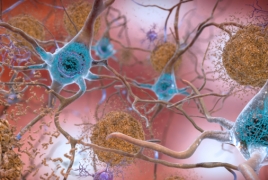Researchers explore brain changes over the course of Alzheimer's March 9, 2019 - 16:22 AMT PanARMENIAN.Net - What changes in the brain are caused by Alzheimer's disease? How do these changes differ from those observed in the normal aging process? Researchers from the CNRS, the école pratique des hautes études (EPHE) and the University of Valencia (Spain) explored these questions by analyzing over 4,000 MRI scans of healthy and diseased brains using the "volBrain" platform. Their models, published in the March 8, 2019 edition of Scientific Reports, reveal an early atrophy of the amygdala and hippocampus at age 40 in patients with Alzheimer's disease, News Medical reports. Alzheimer's disease is characterized by changes in the brain, some of which can be measured in the patient using biomarkers such as the size of different areas of the brain. Studying these biomarkers has shown that certain brain structures shrink in the presence of Alzheimer's well before the first signs of dementia appear. Key questions remained however: when and how did changes in these biomarkers differ between a healthy subject and one with Alzheimer's, for example? To answer these questions, researchers at the Laboratoire bordelais de recherche en informatique (LaBRI) (CNRS/Bordeaux INP/Université de Bordeaux), at the Aquitaine Institute for Cognitive and Integrative Neuroscience (CNRS/Université de Bordeaux/EPHE) and the University of Valencia (Spain) created a model which traces brain changes and activity over an entire life span using a massive set of over 4,000 MRI scans processed with the volBrain1 platform. Prior to this, scientists did not have images covering every period of an Alzheimer patient's life. Researchers suggested modeling the changes generally seen in the volumes of different structures using a vast quantity of samples in order to pinpoint where healthy brains diverged from diseased ones over time. Based on MRI scans from 2,944 healthy control subjects between the ages of 9 months to 94 years old, the team developed a 'normal' model of average brain changes, which they compared to a pathological model based on MRIs from 1,385 Alzheimer's patients aged over 55 and 1,877 young control subjects. Their results show an early divergence between the pathological models and the normal trajectory of aging of the hippocampus before age 40, and of the amygdala around age 40. Both of these structures suffer atrophy in the presence of Alzheimer's disease. Also evident is an early enlargement, in patients with the disease, of an internal cavity in the brain known as the lateral ventricle. This enlargement is part of the aging process in normal subjects too, however, thus limiting the pertinence of this measurement in subjects of an advanced age, and reaffirming the usefulness of studying biomarkers across an entire life span. Developed by the CNRS, the Université de Bordeaux and the University of Valencia in Spain, this free platform allows researchers around the world to upload structural MRI files and obtain in record time an automatic analysis of the scanned brain structure volumes. Since its creation in 2015, over 110,000 brain MRIs have been analyzed for over 2,500 users worldwide. Authorities said a total of 192 Azerbaijani troops were killed and 511 were wounded during Azerbaijan’s offensive. In 2023, the Azerbaijani government will increase the country’s defense budget by more than 1.1 billion manats ($650 million). The bill, published on Monday, is designed to "eliminate the shortcomings of an unreasonably broad interpretation of the key concept of "compatriot". The earthquake caused a temporary blackout, damaged many buildings and closed a number of rural roads. Partner news |